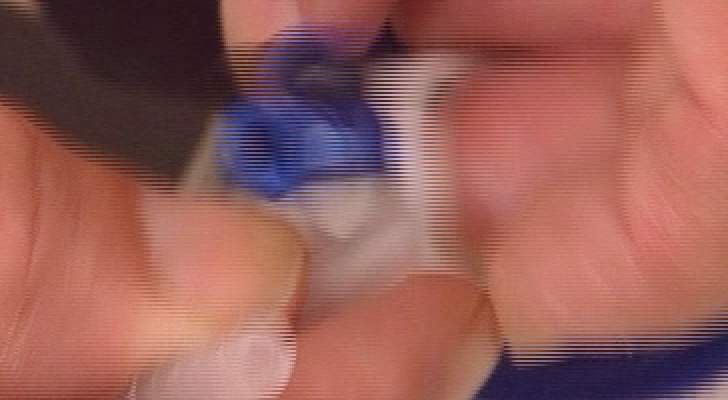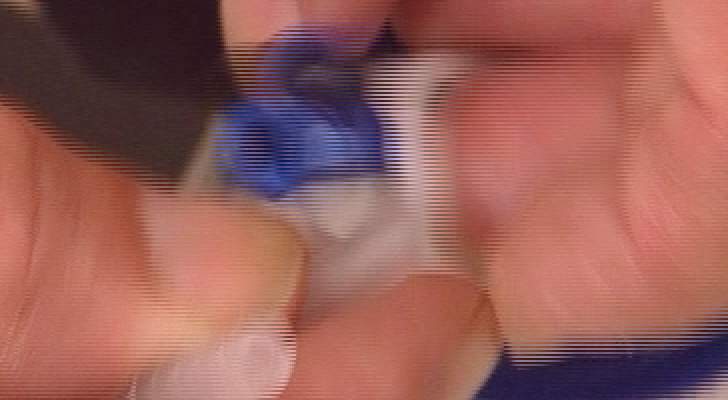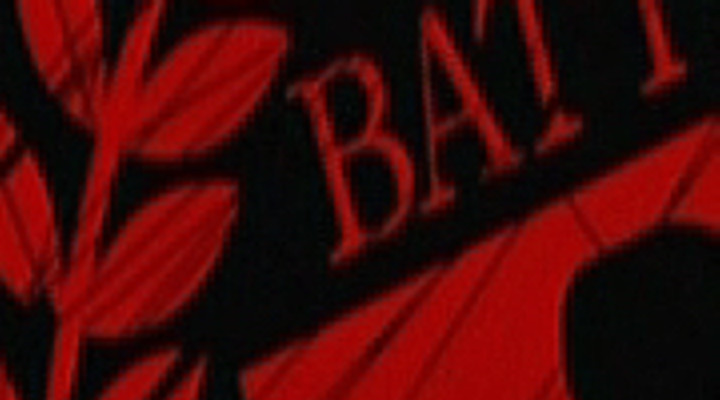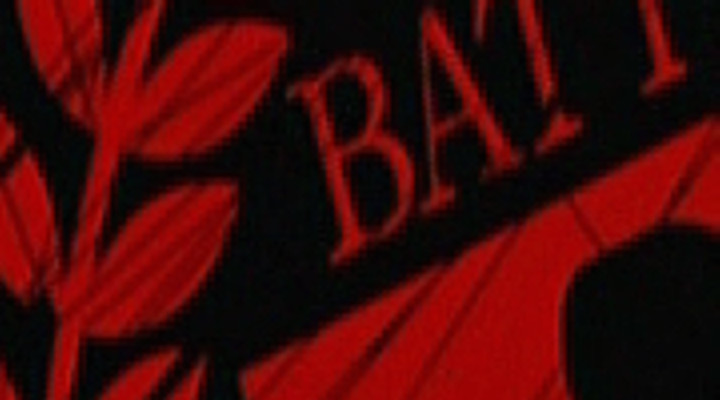
The following figures show errors, which are examples of the Chroma Upsampling Error, called this way because the video is upsampled incorrectly (interlaced YV12 upsampled as progressive or vice versa). As a result, you will often see gaps on the top and bottom of colored objects and "ghost" lines floating above or below the objects.
 |
| figure 1a: example of interlaced source (YV12) being upsampled as progressive video (YUY2) (from http://zenaria.com/gfx/) |
 |
| figure 1b: the same image with correct chroma upsampling (from http://zenaria.com/gfx/) |
 |
| figure 2a: example of progressive source (YV12) being upsampled as interlaced video (YUY2) |
 |
| figure 2b: the same image with correct chroma upsampling |
In this section, it will be shown what causes it, and how to fix it. Where fixing mean making it less visible, because it's not possible to correct it completely.
References:
[The
Chroma Upsampling Error]
[The Chroma Upsampling
Error - Television and Video Advice]
As previously stated, the Chroma Upsampling Error occurs when you convert from (trully) interlaced YV12 to mostly any other format and the converter thinks the video is progressive. Or, the other way around, if material is progressive (or interlaced encoded as progressive), and upsampled as interlaced. This is however not as bad as the other way around.
When VDub previews your video, it will need to convert it to RGB. Since AviSynth delivers YV12, it asks the codec (for example XviD or DivX) to convert YV12 to RGB. The codec however ALWAYS upsamples progressively. Hence you will get artifacts in VDub preview on interlaced YV12 material. This is however not present in the YV12 video (or in the resulting encoding). To confirm this, let AviSynth do the conversion by adding ConvertToRGB(interlaced=true) at the end of your script.
You will have to blur the chroma in some way (leaving the luma intact).
For example (using tomsmocomp.dll):
AviSource(...) MergeChroma(TomsMoComp(-1,5,0))
In this section, the chroma placement will be explained, how this is related to subsampling (RGB -> YUY2 -> YV12) and how the upsampling is done in AviSynth.
It should also explain in detail why the CUE occurs. To summarize the latter, the problem is that there is a difference between YV12 progressive and YV12 interlaced, because the chroma is shared vertically between neighboring pixels.
See also http://forum.doom9.org/showthread.php?s=&threadid=52151&highlight=upsampling.
In order to be able to understand how YV12 <-> YUY2 sampling works and why it matters whether your source is interlaced or progressive, the YV12/YUY2 color formats will be discussed first. It's not important here how they are stored in your memory. Information about that can be found here: ColorSpaces.
The term 4:4:4 denotes that for every four samples of the luminance (Y), there are four samples each of U and V. Thus each pixel has a luminance value (Y), a U value (blue difference sample or Cb) and a V value (red difference sample or Cr). Note, "C" is just a chroma sample (UV-sample).
The layout of a 4:4:4 encoded image looks as follows
| frame | line |
| YC YC YC YC | line 1 |
| YC YC YC YC | line 2 |
| YC YC YC YC | line 3 |
| YC YC YC YC | line 4 |
YUY2 (or YUYV) is a 4:2:2 format. The term 4:2:2 denotes that for every four samples of the luminance (Y), there are two samples each of U and V, giving less chrominance (color) bandwidth in relation to luminance. So for each pixel, it is horizontally sharing UV (chroma) with a neighboring pixel.
The layout of a 4:2:2 encoded image looks as follows
| frame | line |
| YC Y YC Y | line 1 |
| YC Y YC Y | line 2 |
| YC Y YC Y | line 3 |
| YC Y YC Y | line 4 |
For the YV12 color format, there's a difference between progressive and interlaced. The cause is that chroma values are also shared vertically between two neighboring lines.
YV12 is a 4:2:0 format. The term 4:2:0 denotes that for every four samples (two horizontal and two vertical) of the luminance (Y), there is one sample each of U and V, giving less chrominance (color) bandwidth in relation to luminance.
YV12 progressive
For each pixel, it is horizontally sharing UV (chroma or C) with a neighboring pixel and vertically sharing UV with the neighboring line (thus line 1 with line 2, line 3 with 4, etc).
The layout of a progressive 4:2:0 encoded image looks as follows (MPEG 2 scheme - see below)
| frame | line |
| Y_Y_Y_Y | line 1 |
| C___C__ | |
| Y_Y_Y_Y | line 2 |
| Y_Y_Y_Y | line 3 |
| C___C__ | |
| Y_Y_Y_Y | line 4 |
YV12 interlaced
For each pixel, it is horizontally sharing UV (chroma or C) with a neighboring pixel and vertically sharing UV with the next to neighboring line (thus line 1t with line 3t, line 2b with 4b, etc).
The layout of a interlaced 4:2:0 encoded image looks as follows (MPEG 2 scheme - see below)
| frame | line |
| Y_Y_Y_Y | line 1t |
| C___C__ | |
| Y_Y_Y_Y | line 2b |
| Y_Y_Y_Y | line 3t |
| C___C__ | |
| Y_Y_Y_Y | line 4b |
or
| field 1 | field 2 | line |
| Y_Y_Y_Y | line 1t | |
| C___C__ | ||
| Y_Y_Y_Y | line 2b | |
| Y_Y_Y_Y | line 3t | |
| C___C__ | ||
| Y_Y_Y_Y | line 4b | |
Subsampling is used to reduce the storage and broadcast bandwidth requirements for digital video. This is effective for a !YCbCr signal because the human eye is more sensitive for changes in black and white than for changes in color. So drastically reducing the color info shows very little difference. YUY2 and YV12 are examples of reduced color formats.
More about RGB -> YUV color conversions can be found here: ColorConversions.
Recall the layout of a 4:4:4 encoded image
| frame | line |
| YC1 YC2 YC3 YC4 | line 1 |
| YC1 YC2 YC3 YC4 | line 2 |
| YC1 YC2 YC3 YC4 | line 3 |
| YC1 YC2 YC3 YC4 | line 4 |
In AviSynth, the default mode is using a 1-2-1 kernel to interpolate chroma, that is
C1x = (C1+C1+C1+C2)/4 (C1 is used three times, since this is the border)
C3x = (C2+C3+C3+C4)/4
C5x = (C4+C5+C5+C6)/4
The 4:2:2 encoded image becomes
| frame | line |
| Y1C1x Y2 Y3C3x Y4 | line 1 |
| Y1C1x Y2 Y3C3x Y4 | line 2 |
| Y1C1x Y2 Y3C3x Y4 | line 3 |
| Y1C1x Y2 Y3C3x Y4 | line 4 |
The other mode ConvertBackToYUY2 uses chroma from the left pixel, thus
| frame | line |
| Y1C1 Y2 Y3C3 Y4 | line 1 |
| Y1C1 Y2 Y3C3 Y4 | line 2 |
| Y1C1 Y2 Y3C3 Y4 | line 3 |
| Y1C1 Y2 Y3C3 Y4 | line 4 |
Note (as with the layout of other formats) the position of the chroma values, represent the WEIGHT result of the subsampling.
YUY2 -> YV12 interlaced conversion
Recall the layout of a interlaced 4:2:0 encoded image, but with the weights included:
| frame | line | weights |
| Y_Y_Y_Y | line 1t | |
| C___C__ | chroma of YUY2_lines (0.75)*1t + (0.25)*3t |
|
| Y_Y_Y_Y | line 2b | |
| Y_Y_Y_Y | line 3t | |
| C___C__ | chroma of YUY2_lines (0.25)*2b + (0.75)*4b |
|
| Y_Y_Y_Y | line 4b | |
or
| field 1 | field 2 | line | weights |
| Y_Y_Y_Y | line 1t | ||
| C___C__ | chroma of YUY2_lines (0.75)*1t + (0.25)*3t |
||
| Y_Y_Y_Y | line 2b | ||
| Y_Y_Y_Y | line 3t | ||
| C___C__ | chroma of YUY2_lines (0.25)*2b + (0.75)*4b |
||
| Y_Y_Y_Y | line 4b | ||
Note (as with the layout of other formats) the position of the chroma values, represent the WEIGHT as a result of the subsampling.
Thus the chroma is stretched across two luma lines in the same field!
YUY2 -> YV12 progressive conversion
Recall the layout of a 4:2:0 encoded image
| frame | line | weights |
| Y_Y_Y_Y | line 1 | |
| C___C__ | chroma of YUY2_lines (0.5)*1 + (0.5)*2 |
|
| Y_Y_Y_Y | line 2 | |
| Y_Y_Y_Y | line 3 | |
| C___C__ | chroma of YUY2_lines (0.5)*3 + (0.5)*4 |
|
| Y_Y_Y_Y | line 4 | |
Note (as with the layout of other formats) the position of the chroma values, represent the WEIGHT result of the subsampling.
Thus the chroma is stretched across two luma lines in the same frame!
Recall the layout of a 4:2:2 encoded image
| frame | line |
| Y1C1 Y2 Y3C3 Y4 | line 1 |
| Y1C1 Y2 Y3C3 Y4 | line 2 |
| Y1C1 Y2 Y3C3 Y4 | line 3 |
| Y1C1 Y2 Y3C3 Y4 | line 4 |
For the 4:2:2 -> 4:4:4 conversion, the missing chroma samples are interpolated (using a 1-1 kernel), that is
C2x = (C1+C3)/2
C4x = (C3+C5)/2
and the existing chroma samples are just copied.
The 4:4:4 encoded image becomes
| frame | line |
| Y1C1 Y2C2x Y3C3 Y4C4x | line 1 |
| Y1C1 Y2C2x Y3C3 Y4C4x | line 2 |
| Y1C1 Y2C2x Y3C3 Y4C4x | line 3 |
| Y1C1 Y2C2x Y3C3 Y4C4x | line 4 |
In AviSynth, the missing chroma samples are interpolated as follows
| frame | line | weights |
| Y_Y_Y_Y | line 1t | chroma of YV12_lines 1t |
| C___C__ | ||
| Y_Y_Y_Y | line 2b | chroma of YV12_lines 4b |
| Y_Y_Y_Y | line 3t | chroma of YV12_lines (0.75)*1t + (0.25)*5t |
| C___C__ | ||
| Y_Y_Y_Y | line 4b | chroma of YV12_lines (0.75)*4b + (0.25)*8b |
| Y_Y_Y_Y | line 5t | chroma of YV12_lines (0.25)*1t + (0.75)*5t |
| C___C__ | ||
| Y_Y_Y_Y | line 6b | chroma of YV12_lines (0.25)*4b + (0.75)*8b |
| Y_Y_Y_Y | line 7t | chroma of YV12_lines (0.75)*5t + (0.25)*9t |
| C___C__ | ||
| Y_Y_Y_Y | line 8b | chroma of YV12_lines (0.75)*8b + (0.25)*12b |
or
| field 1 | field 2 | line | weights |
| Y_Y_Y_Y | line 1t | chroma of YV12_lines 1t |
|
| C___C__ | |||
| Y_Y_Y_Y | line 2b | chroma of YV12_lines 4b |
|
| Y_Y_Y_Y | line 3t | chroma of YV12_lines (0.75)*1t + (0.25)*5t |
|
| C___C__ | |||
| Y_Y_Y_Y | line 4b | chroma of YV12_lines (0.75)*4b + (0.25)*8b |
|
| Y_Y_Y_Y | line 5t | chroma of YV12_lines (0.25)*1t + (0.75)*5t |
|
| C___C__ | |||
| Y_Y_Y_Y | line 6b | chroma of YV12_lines (0.25)*4b + (0.75)*8b |
|
| Y_Y_Y_Y | line 7t | chroma of YV12_lines (0.75)*5t + (0.25)*9t |
|
| C___C__ | |||
| Y_Y_Y_Y | line 8b | chroma of YV12_lines (0.75)*8b + (0.25)*12b |
|
AviSynth uses a different interpolation as the one suggested by the mpeg2 specs (perhaps due to speed issues). The latter is
| field 1 | field 2 | line | weights |
| Y_Y_Y_Y | line 1t | chroma of YV12_lines 1t |
|
| C___C__ | |||
| Y_Y_Y_Y | line 2b | chroma of YV12_lines 4b |
|
| Y_Y_Y_Y | line 3t | chroma of YV12_lines (5/8)*1t + (3/8)*5t |
|
| C___C__ | |||
| Y_Y_Y_Y | line 4b | chroma of YV12_lines (7/8)*4b + (1/8)*8b |
|
| Y_Y_Y_Y | line 5t | chroma of YV12_lines (1/8)*1t + (7/8)*5t |
|
| C___C__ | |||
| Y_Y_Y_Y | line 6b | chroma of YV12_lines (3/8)*4b + (5/8)*8b |
|
| Y_Y_Y_Y | line 7t | chroma of YV12_lines (5/8)*5t + (3/8)*9t |
|
| C___C__ | |||
| Y_Y_Y_Y | line 8b | chroma of YV12_lines (7/8)*8b + (1/8)*12b |
|
YV12 progressive conversion -> YUY2
The missing chroma samples are interpolated as follows
| frame | line | weights |
| Y_Y_Y_Y | line 1 | chroma of YV12_lines 1 |
| C___C__ | ||
| Y_Y_Y_Y | line 2 | chroma of YV12_lines (0.75)*1 + (0.25)*3 |
| Y_Y_Y_Y | line 3 | chroma of YV12_lines (0.25)*1 + (0.75)*3 |
| C___C__ | ||
| Y_Y_Y_Y | line 4 | chroma of YV12_lines (0.75)*3 + (0.25)*5 |
| Y_Y_Y_Y | line 5 | chroma of YV12_lines (0.25)*3 + (0.75)*5 |
| C___C__ | ||
| Y_Y_Y_Y | line 6 | chroma of YV12_lines (0.75)*5 + (0.25)*7 |
ColorSpaces
[4:4:4] sampling
[4:2:2] sampling
[4:2:0] sampling
[Chroma
Upsampling]
[Chroma Subsampling Standards]
There are two common variants of 4:2:0 sampling. One of these is used in MPEG-2 (and CCIR-601) video, and the other is used in MPEG-1. The MPEG-2 scheme is how AviSynth samples 4:2:0 video, because it completely avoids horizontal resampling in 4:2:0 <-> 4:2:2 conversions.
The layout of a progressive MPEG-1 4:2:0 encoded image
| frame | line | weights |
| Y_Y_Y_Y | line 1 | |
| _C__C_ | chroma of YUY2_lines (0.5)*1 + (0.5)*2 |
|
| Y_Y_Y_Y | line 2 | |
| Y_Y_Y_Y | line 3 | |
| _C__C_ | chroma of YUY2_lines (0.5)*3 + (0.5)*4 |
|
| Y_Y_Y_Y | line 4 | |
The layout of a MPEG-2 4:2:0 encoded image
| frame | line | weights |
| Y_Y_Y_Y | line 1 | |
| C___C__ | chroma of YUY2_lines (0.5)*1 + (0.5)*2 |
|
| Y_Y_Y_Y | line 2 | |
| Y_Y_Y_Y | line 3 | |
| C___C__ | chroma of YUY2_lines (0.5)*3 + (0.5)*4 |
|
| Y_Y_Y_Y | line 4 | |
For completeness, we will mention DV sampling. DV is 4:2:0 (PAL) and 4:1:1 (NTSC). Note, that the sample positioning of the former is different from the 4:2:0 chroma in MPEG-1/MPEG-2!
The layout of a 4:2:0 encoded image (field-based)
| field | line |
| YV Y YV Y YV Y YV Y | line 1 |
| YU Y YU Y YU Y YU Y | line 2 |
| YV Y YV Y YV Y YV Y | line 3 |
| YU Y YU Y YU Y YU Y | line 4 |
The layout of a 4:1:1 encoded image (field-based)
| field | line |
| YC Y Y Y YC Y Y Y | line 1 |
| YC Y Y Y YC Y Y Y | line 2 |
| YC Y Y Y YC Y Y Y | line 3 |
| YC Y Y Y YC Y Y Y | line 4 |
Some comments about this formats:
- 4:1:1 is supported natively in AviSynth v2.6.
- DV decoders all output YUY2 or RGB (with the exception of ffdshow when YV12 is enabled).
- When outputting YUY2/RGB (NTSC), the MainConcept codec duplicates the chroma samples instead of interpolating. The
[ReInterpolate411
plugin] can be used to correct for this, resulting in better quality.
[MSDN:
YUV sampling] Describes the most common YUV sampling techniques.
[DV sampling]
In general interlaced content will have static parts. If it is upsampled correctly using interlaced upsampling, it will still have chroma problems on diagonal edges of bright-colored objects in static parts of a frame. The reason is that "When the two fields are put back together later by a deinterlacer (or by your eye and brain, if you watch it on an interlaced TV), the relatively smooth gradations and contours of each field are broken up by a slightly different set of gradations and contours from the other field." (quote from first reference). This is called the Interlaced Chroma Problem. The "solution" is a motion-adaptive upsampler, but such an AviSynth/VDub filter which attempts to do this doesn't exist yet.
References:
[The
4:2:0 Interlaced Chroma Problem]
[The 4:2:0 Interlaced
Chroma Problem - Television and Video Advice]
$Date: 2008/07/11 18:23:00 $